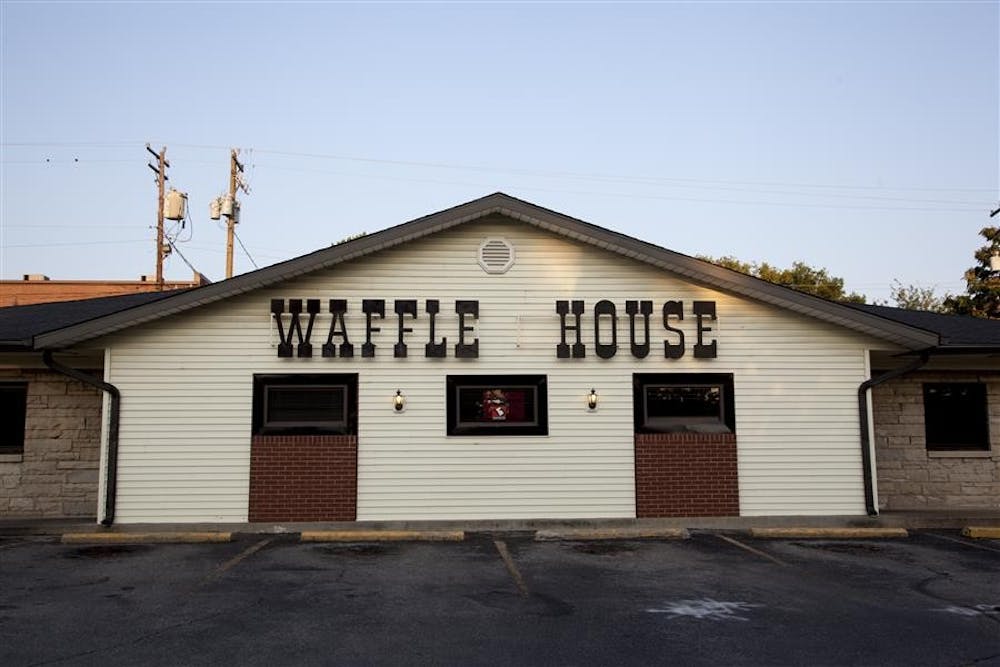On the last morning, before the waffle irons went cold and the pictures came down, before the lock refused to lock, before the claw crashed through the roof, the old man paced.
Tap, tap, tap. Bud Powell’s aluminum cane led the way as he circled the floor of Bloomington’s Waffle House. His Waffle House.
That Wednesday in September, the owner didn’t know what to do with himself. The smell of frying oil, the same greasy perfume that had greeted customers for 46 years, wafted into his nose as he wandered past the vinyl booths. He sat down, then stood
up again.
Bud — everyone called him Bud — checked on the dwindling supply of breakfast sausage, peered into the nearly empty freezers, tried to explain to his regulars why it had to be this way.
“It’s time,” he said over and over.
At 79, Bud was tired. Except for Christmas, the restaurant was always open, day and night. Now a developer wanted to replace it with another apartment building for college kids. The offer was too good to pass up.
“Where are we gonna eat?” the old-timers kept asking.
“I don’t know,” Bud said. “Where am I gonna eat?”
This had been his place for 16,767 mornings. None ever felt like this.
The weariness showed in his eyes, behind the wire rim glasses and in the hunch of his shoulders. After the Waffle House was torn down, he knew that he wouldn’t see most of his customers again.
Tap, tap, tap. Bud plodded past the grill, where the last of the eggs sizzled. The ever-dependable waitresses whizzed by, balancing plates, like today was no different.
Most of the students had stopped visiting years ago. The smoking ban forced out the puffers. Many of the regulars grew so old that they died or went to nursing homes.
Once Bud decided to close, it all slipped away even faster. Some of his staff had taken other jobs. The gumballs emptied out of the shiny red machine. No one bothered to mark the white board with the daily special.
They would close at precisely 3 p.m. Bud checked his watch, ignoring the broken wall clock, its hands frozen for more years than he could remember, stuck in time.
It suited the place.
* * *
The Waffle House was the second oldest restaurant in Bloomington, established only after Nick’s English Hut.
Bud Powell and his wife Myra opened the restaurant, one of the first Waffle House franchises in the country, on Oct. 10, 1967. Its first year of business saw IU football’s first and last trip to the Rose Bowl, Nixon’s successful run for the presidency and the death of Martin Luther King Jr.
It was the kind of place you could come alone and still end up talking to a dozen people. Students stumbled in between late-night bar stops, and senior citizens rolled their walkers in before doctor appointments. Cops hung out there so often, it seemed no coincidence the place was never robbed.
The legends showed up from time to time — Bobby Knight, Woody Hayes — but it was the regulars who received special treatment. Everybody knew everybody. Senior night was Tuesday. You could bring your girlfriend, your kids, your mother-in-law — everyone was family.
You’d scoot into a scuffed booth, turn your well-worn mug right side up and look over the laminated menu, but you already knew what they were serving. At all hours, you could order waffles. Or strip steak. Or corn dogs. But it didn’t really matter, because going to the Waffle House wasn’t about the food.
It was about walking into a place where the fastest moving thing would be the coffee pouring into your cup. No matter what was going on in the world outside, no matter how your life was changing, the Waffle House would be there — the smell, the fake plants, the ceiling cracks — always open, always the same.
* * *
A week before the last day, the food was already running out.
Dr. Dick Leyda slid into a booth for a meal he ordered a few times a week – sandwich and soup. He kept it simple.
“Chicken salad sandwich, please,” he told Mary, who had been working there for 24 years.
“We’re out of that, dear,” Mary said.
“Ham salad?”
“That too.”
Dr. Leyda settled for egg salad. He was one of the few people at the restaurant who wasn’t called by his first name. But mostly he’d be called “dear” or “honey” anyway.
A few years before, he had rarely been seen at the Waffle House, or anywhere else, without his wife Carole. When Carole started needing a walker to get around, they still came to the restaurant. She’d order French toast and bacon from Hootie, one of their favorite waitresses.
Always French toast and bacon.
At home, Carole wasn’t so predictable. Without Dr. Leyda ever really noticing, his wife had begun filling up their children’s old bedrooms with newly bought items. Shoes still in their boxes, beautiful shirts and dresses from Talbots in the closet, never worn. Carole had never been a big shopper, and certainly not a hoarder.
“Dad,” said their daughter. “I think Mom is having problems.”
Carole was diagnosed with Alzheimer’s. Slowly, she forgot how to walk. When they went to Waffle House, Dr. Leyda brought a caregiver who could help her inside. Dr. Leyda read the menu out loud. Carole ordered French toast and bacon.
Then two years ago, Carole moved into Garden Villa, a senior center. She and her husband still ate together each morning, usually popsicles or chocolate bars. They sang together — ”Amazing Grace,” “God Bless America” and “A Bicycle Built for Two.”
Carole used to sing with him. Now, she mouthed the words. He always kissed her goodbye, and she always kissed back, except for when she wasn’t ready for him to leave.
When Dr. Leyda drove away, he headed straight to the Waffle House.
“How’s Carole doing this week?” Mary always asked, coffee pot in hand.
“Oh, good, good,” he said. “She lights up when I come in the room.”
Sometimes Dr. Leyda ate with Bud, sometimes with an insurance salesman, from whom he never bought insurance. Often he ate alone, but with so many waitresses who knew him, it wasn’t really like being alone at all. Today he sat with Rose Thomas, his neighbor on Covenanter Drive.
“He comes in here nine days a week,” Rose said.
So did she. Other than her church, the Waffle House was about the only place Rose felt comfortable going alone since Stan, her husband of 65 years, passed away last year. They used to eat at the restaurant together. From time to time she’d retell how the two of them met, a long and winding story involving a Ouija board and a flirtatious secretary rival. Now going on two years without him, Rose still talked to Stan’s picture on the wall above her piano.
Her meal of choice was a Reuben and cobbler. Usually she lingered to chat and joke with Mary the waitress about how old the two of them were getting.
“You remember when Martha Washington lent me her dress?” she said. “I’ve never been able to use it here. You know, the red one with the white lacy cuffs?”
When she found out Waffle House was closing, Rose asked Bud if she could buy the restaurant’s dishware to donate it to her church. He told her she could have it for free.
* * *
On the final morning, Dr. Leyda kissed Carole goodbye at Garden Villa. He was pretty sure she understood he was headed to their old place.
“Well, this is gonna be the last time,” he said. She smiled.
He arrived at the restaurant to find Rose already inside. He had eggs, toast and ham. She had peach cobbler. Bud continued his circling, waiting for his watch to read 3 p.m.
The freezer was empty now, except for one lonely cardboard box on the bottom shelf. John the dishwasher loaded each dish carefully into the industrial washing machine.
“Those are clean, John,” Bud said.
“I know, I know,” John mumbled. “Just doing it one more time, just to be sure.”
Bud’s son Eric came through the kitchen door.
“Are you ready to take the photos down?” Bud asked him.
“No, let’s just wait.”
A customer had brought a white sheet cake, decorated with yellow icing letters that read, “Waffle House, 1967-2013.” Bud snagged a piece, found a booth and leaned his cane on the burgundy tabletop.
For years he had sat in these booths, looking out the window and watching the world change in ways he never could have imagined. The A&W drive-in across the street, the bus station one lot over, the pizza shop next door — one by one, all of them had been knocked down to make way for more apartments for college students. Within a year, the new five-story apartment building would rise right where he was
sitting now.
He glanced down at his watch again.
Finally, 3 p.m. had arrived.
This is it, he thought. He helped himself to a heaping spoonful of cake. And a few more.
“Bud, the door won’t lock.”
He looked up. Larry, the day’s manager, stood at the booth. After taping up handwritten “We are closed” signs, he had just spent five minutes fumbling at the door. The place hadn’t been closed since Christmas, and now the key wouldn’t turn.
“The north door,” Larry said again. “It won’t lock.”
Bud almost smiled.
* * *
That evening, some volunteers from St. Charles Catholic Church helped Rose pick up the dishware. Once the boxes were unloaded, she stopped in a pew to pray. For Bud, for his wife Myra, for Stan.
By the time she reached home, she was already imagining the donated dishes gracing a proper after-church coffee gathering. Some people might think paper cups were acceptable, but she knew better.
She looked up at the framed portrait of her white-mustached husband in the corner.
“Isn’t that right, Stan?”
* * *
The next morning, Dr. Leyda and Carole started the day with mini Hershey’s bars on the patio of Garden Villa. They watched the residents move slowly in and out of the rehab center doors. Some of the residents waved to Carole.
Dr. Leyda kissed her goodbye and pondered where to go next. Panera? Or Cheddar’s? McAlister’s?
Maybe Bob Evans. He liked Bob Evans. Not the food. But Hootie, his favorite old Waffle House waitress, worked there now.
* * *
Rain drizzled on a small cluster of witnesses. John the dishwasher and his girlfriend’s cousin. Bud’s son Eric in a pinstripe suit. They ignored the squishing in their shoes.
Bud wasn’t there. Eight days into retirement, a pain in his right hip had sent him to the hospital. He’d been determined to see this, but was still recovering from hip replacement surgery.
There was no eulogy or last words. The claw of a yellow CAT excavator dug into the corner of the Waffle House roof. With a crunch muffled by the rain, it all crashed down — the walls, the support beams, the fluffs of pink insulation.
The claw rose again and took its next bite. Chunk by chunk, the Waffle House became rubble.
“Maybe it’s better,” Eric said. “Maybe it’s better that he didn’t see it like this.”
Follow reporter Jessica Contrera on Twitter @mjcontrera and photographer Anna Teeter @annateeter.






